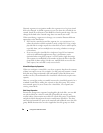
Using Your RAID Enclosure 43
Storage partitions give multiple host servers or host groups access to the same
host server-to-virtual disk mappings. With these mappings, you can control
which host server or host group may have access to a virtual disk in your
storage array.
The first time you map a virtual disk to a specific host server or host group, a
storage partition is created. Any subsequent mappings to that host server or
host group do not create new storage partitions.
Under the following conditions, only a single storage partition is required:
• You have only one attached host server that will access all of the virtual
disks in the storage array. A single host server can be attached to only one
partition.
• You plan to have all attached host servers share access to all virtual disks on
the storage array. When you choose this type of configuration, all of the
host servers must have the same operating system and must have special
software (such as clustering software) to manage virtual disk sharing and
accessibility.
If either of the following is true, you must use more than one storage
partition:
• You want specific host servers to access specific virtual disks in the storage
array.
• You have host servers with different operating systems attached to the
same storage array.
NOTE: The storage array can support up to 16 storage partitions.
Host Server-to-Virtual Disk Mapping
The host server attached to a storage array accesses various virtual disks on
the storage array through its host ports. Specific virtual disk-to-LUN
mappings to an individual host server can be defined. In addition, the host
server can be part of a host group that shares access to one or more virtual
disks.


















